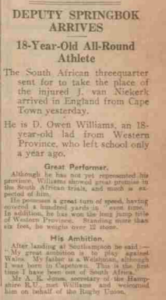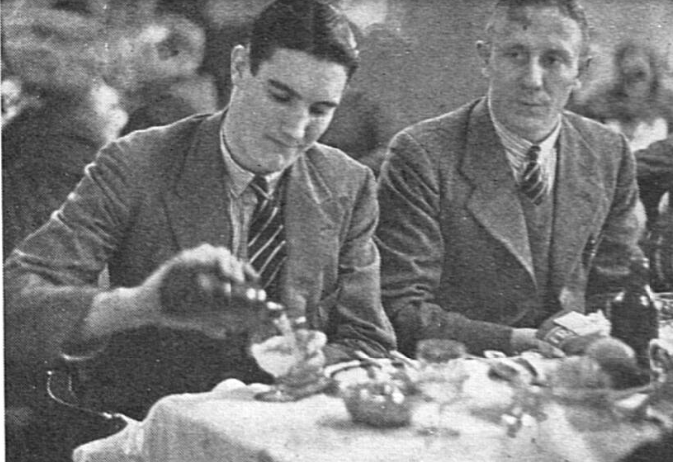Question: Who is the best Welsh wing of all-time?
Answer: Take your pick from the likes of Willie Llewellyn, Johnnie Williams, Ken Jones, Dewi Bebb, Stuart Watkins, Maurice Richards, Gerald Davies, JJ Williams, Ieuan Evans, Gareth Thomas, Shane Williams or George North and many more.
Wayne Pivac is blessed with the number of quality players he has to pick from in South Africa to play on the wing. Josh Adams and Louis Rees-Zammit are both spectacular finishers and then there are George North and Liam Williams who can turn their hand to playing wide out.
Everyone has their own favourite when asked the question, but who would you pick out as the greatest Welsh-qualified wing who never played for Wales?
Sounds an impossible question to answer, but in fact it’s very easy. Look no further than the former Springbok flier, David Owen Williams. With a name like that he couldn’t be anything other Welsh!
Wales has selected its fair-share of South African-born players down the years. Mike Davies was a Rhodes Scholar at Oxford University who won two caps as a centre for Wales in 1939, while Ian Jones won a single cap while playing second row for London Welsh in 1968.
More recently, Dragons prop Rhys Thomas won seven caps between 2006-09, Hal Luscombe was a Grand Slammer in 2005 and won 16 caps, while Ospreys lock Ian Evans, who was born in Johannesburg, earned 33 caps and a British & Irish Lions tour.
But did you know that as well as Welsh qualified Dai Williams – his father was from Brecon – the Springboks also capped Abergavenny-born Joseph ‘Birdie’ Partridge against the 1903 Lions.
WHO WAS DAI WILLIAMS

Born in Mowbray, in Cape Town in 1913, his Welsh speaking father had emigrated to South Africa. He was educated at one of the most famous rugby nurseries in the world game, Diocesan ‘Bishops’ College. By the time he left he was recognised as a brilliant all-round athlete with a chance of Springbok and even Olympic honours ahead of him.
An even-time sprinter over 100 yards, he won the Western Province long jump title and was elected captain of the Celtic Harriers Athletic Club. He was quick, agile and a real powerhouse when in full stride, standing 6ft 1in tall and weighing in at more than 13st 7lbs.
His breakthrough on the rugby field came when he was called out to the UK to replace Jock van Niekerk after he picked up a knee injury in the first game of the 1931-32 Springboks tour. At that stage he was playing for Villagers club side, had had a Springbok trial, but hadn’t played for Western Province.
He was the youngest player to go on tour with the Springboks at 18 years, 4 months and joined Bennie Osler’s side on 16 November after undergoing a 17 day sea voyage from Cape Town.
After disembarking the Union Castle liner Kenilworth Castle at Southampton, he immediately referenced his Welsh roots: “My great ambition is to play against Wales. My father is a Welshman, although I was born in Cape Town, and this is the first time I have been out of South Africa,” he told reporters.
He found himself in action for the first time in a Springbok jersey at Cardiff Arms Park, albeit against Cardiff rather than Wales. That was a week after landing and he helped his side win 13-5.

Three days later scored a try in a 9-0 win over Llanelly at Stradey Park, helping to inflict a first defeat on the Scarlets on their own patch in two years. It was the first of 17 tries he scored for the Springboks in 18 appearances in the famous green jersey.
He sat out the games against Neath & Aberavon Combined and Wales, both won 8-3 by the tourists, before making his third appearance against Lancashire and Cheshire. The game ended in a convincing 20-9 win for Osler’s men, but it came at a price as Williams broke his collar-bone and didn’t play again on tour and two other players had to leave the field.
Back home in South Africa, Williams played for Western Province between 1932-43, won the Currie Cup in 1932 and shared the title with Border in 1934 and 1936 and played in the first play-off final in 1939.
He temporarily lost form in 1933, missing the home Test series against the Wallabies, but returned for the Springboks’ next international assignments in Australia and New Zealand in 1937. It was on that tour that he proved himself to be arguably the best wing in the world as the South African’s won both Tests against the Wallabies and then became the first team to beat the All Blacks in a home series.
His international debut came in the 1st Test in Australia on 26 June, 1937 and he made eight consecutive appearance for the Springboks on the Test stage, scoring five tries. Three of those came on the 1937 tour down under, where he scored three in five games in Australia and 12 in nine games in New Zealand.
A year later he became the tormentor of the British & Irish Lions, facing Sammy Walker’s team five times and winning four of them. His only defeat came in the third Test, by which time the Springboks had wrapped up the series thanks to two tries from Williams in the opening Test.
CLICK BELOW TO SEE DAI WILLIAMS SCORING TWICE AGAINST THE LIONS.
So, just how good was he? Not many players have won Test series in Australia and New Zealand and then beaten the Lions at home
This is the glowing tribute paid to him by J.T de Villiers in his review of South African rugby for the Matamata Record, in New Zealand, on 6 November, 1939
Dai Williams (Western Province)
Public enemy number one from New Zealand’s point of view. Williams needs no Introduction to South African Rugby fans. He is in a class all by himself. When he is assisting with a big job, Williams is here, there and everywhere, in turn swinging into the back line, torpedoing for the try line, sending over bewildering cross-kicks, dive-tackling and covering up in defence. Williams is in the heyday of his football career, being only 25 years old and possessed of any amount of “devil.” And considering that he stands 6ft 1in and scales round about 14 stone, I am glad that an All Black will be marking him next year and not I.
A George North style wing with the pace of Louis Rees-Zammit? Just imagine having to face a player best with their virtues combined!
He may have been born in South Africa, but he sounds typically Welsh!

